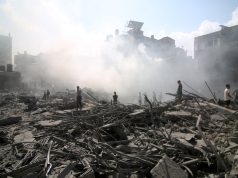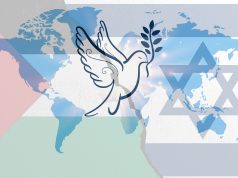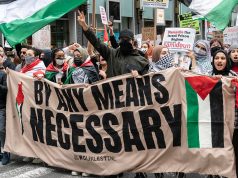.
By Rachel Avraham
The wave of protests in Iran, which began following the mysterious death of the young Iranian woman, Mehsa Amini, after she was arrested for her “immodesty”, is intensifying. Alongside the opposition to the religious rule of the Revolutionary Guards and in addition, because of the apparent success, a demand arose from the people living under Persian occupation for national independence. After all, Iran was originally the Persian Empire ruled by the Shah, similar to Turkey, which was part of the Ottoman Empire and ruled by the Sultan.
As befits an empire, the Persian Empire ruled over vast territories it conquered and not only over the Persians. The last king of the Persian Empire, or rather the last shah, was Shah Muhammad Reza Pahlavi (of the Pahlavi dynasty) who fled Iran during the Islamic revolution in 1979. After the revolution, the Persian Empire became the Islamic Republic of Iran, controlled by the Revolutionary Guards and the Shia clerics in Iran.
But even though it became a republic, Iran still ruled over all those nations that were conquered by the conquests of the Persian Empire over the years. Under the Persians live peoples such as: Arabs, Turkmens, Azeris, and Kurds (and there are more), but in this article, we will focus on the Baluchi people under Persian rule and their demand for an independent state separate from Shia Iran, following the demonstrations that manage to threaten the Revolutionary Guards regime.
The Baloch are an Iranian, Indo-European people, living mainly in Iran, Afghanistan, and Pakistan. According to them, they descend from the Prophet Muhammad Amir Hamza’s uncle, whose descendants immigrated from the city of Aleppo in Syria to the eastern region of Iran at the end of the seventh century. Most of the Baluchis in Iran live in the southeastern province of “Sistan and Balochistan” which is located adjacent to the borders of Afghanistan and the Pakistan border, which also has a Baluchi population across the border in these countries.
The name of the province is “Sistan and Balochistan” which consists of the Iranian Balochistan region (since there is a Balochistan province in Pakistan as well) and the Sistan region which have been joined together into one province where both the Baloch and the Sistanis (two different peoples) live together. Since the religion of the Baloch is Sunni Islam, the Revolutionary Guards regime entrusted most of the political and administrative power in the province of “Sistan and Baluchistan” to the Sistanis, who are a Shiite Persian people. This is how the Revolutionary Guards’ rule oppresses the Sunni Baluchi population, and they cannot rule even in the district where they are considered the absolute majority.
The division into Iranian Balochistan (western) and Pakistani (eastern) Balochistan was made by the British in the 19th century, when the eastern part of Balochistan came into British hands and was part of Greater India and the western part of Balochistan came under the control of the Persian Empire. Until the Islamic revolution in 1979, the demands of the Baloch were met positively by the heads of the Persian government, but after the rise of the Ayatollahs, the situation of the Baloch in Iran deteriorated greatly.
Since the Balochs are not only an ethnic minority but a religious minority, the goal of the Revolutionary Guards was to make the Baloch lose their unique identity through the use of force. A person who did not agree to convert from Sunni Islam to Shiite Islam found it difficult to get a job and study. The names of the streets and cities in the province of “Sistan and Balochistan” were changed from their original names in the Baluchi dialect to Persian names adapted to Persian culture. The Iranian regime encouraged internal migration to the province to dilute the concentration of the Baloch population and thus weaken their political power. According to the “Voice for the Baloch Missing” organization, half of those executed in Iran came from the Baloch community, probably because of political ambitions that do not match the ambitions of the Revolutionary Guards.
These actions are intended to weaken the Baloch as a political opposition force to the Revolutionary Guards, and make them give up any political aspirations for independence and separation from Iranian society. The regime makes it impossible for anyone to live in Iran if he does not follow the rules of the Islamic Republic.
In addition to all this, the economic situation among the residents of the province of “Sistan and Baluchistan” is one of the worst in Iran and it has the lowest per capita income. 80% of the residents live below the poverty line. Probably, as a result, the highest infant mortality in Iran occurs in this province. The absurdity of the whole situation that the Baloch are in is that the province of Sistan and Balochistan is very rich in gas, oil, uranium, copper, and gold, but the residents of the province do not benefit from it at all.
The story that led to the current wave of protests in Iran is the mysterious death of Mehsa Amini two days after she was arrested on September 16. About two weeks later, on November 30, the people of Zahedan (the capital city of Sistan and Balochistan province) gathered to protest the rape of a 15-year-old Baloch girl by an Iranian police chief, who was not punished for it. On the same day, the Revolutionary Guards cleared the demonstration with live fire at the demonstrators. 66 Baloch were killed that day, including teenagers. Three days later, on 03.10.22, a 24-year-old girl named Faiza Barahoi was arrested, accused of inciting the students who participated in the demonstration. Her friends claimed that she was not trying to agitate or lead a rebellion, but only to demand an investigation into the rape of the Baloch girl and suitable punishment for the rapist. After she was arrested at the beginning of October, her trial only took place on the first of November, but for the trial she had to continue waiting two weeks in prison conditions, with severe torture. We don’t know if she’s alive or dead.
According to the situation in Iran at the moment, it is impossible to know if the revolutionary guards’ rule of the Ayatollahs will last for years. Like the other minorities living in Iran, the Baloch dream of their own nation-state and look to Azerbaijan. The difference between the Azeris living in Iran and the Azeris living in Azerbaijan is that the Azeris living in Azerbaijan were once controlled by the Soviet Union. When it disintegrated, and the Azeris gained their independence.
This is the dream of the minorities in Iran, to break away from the Persian Empire that has ruled over them so harshly for years. If the rule of the Revolutionary Guards ends under the pressure of the wave of protests, the Baloch will have an opportunity to establish an independent state in the territories of Western Balochistan. It will be a country with its own culture, its own history, and its own natural treasures, that will make the standard of living of the Baloch much higher than it is now.
This is the story of the Baloch people now living in Iran.
 Rachel Avraham is a political analyst working for the Safadi Center for International Diplomacy, Research, Public Relations and Human Rights, which is run by Mendi Safadi, a former Likud Candidate for the Knesset and a former chief of staff of former Israeli Communication Minister Ayoob Kara. Since 2012, she has been working as an Israel-based journalist and writer, covering Iran, Kurdistan, Turkey, Iraq, Syria, the Israeli-Palestinian conflict, and other developments in the greater Islamic world.
Rachel Avraham is a political analyst working for the Safadi Center for International Diplomacy, Research, Public Relations and Human Rights, which is run by Mendi Safadi, a former Likud Candidate for the Knesset and a former chief of staff of former Israeli Communication Minister Ayoob Kara. Since 2012, she has been working as an Israel-based journalist and writer, covering Iran, Kurdistan, Turkey, Iraq, Syria, the Israeli-Palestinian conflict, and other developments in the greater Islamic world.
Her articles have appeared in the Washington Times, the Hill, Front Page Magazine, the Daily Wire, the Christian Post, the Baltimore Jewish Times, the Jerusalem Post, Israel Hayom, Ahval and many other publications across the globe. She received her MA in Middle Eastern Studies from Ben-Gurion University. She got her BA in Government and Politics with minors in Jewish Studies and Middle Eastern Studies from the University of Maryland at College Park.





